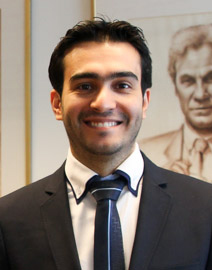
Mohamed ElSalhy is the recipient of two very prestigious awards - the 2015 Alberta Innovates Health Solutions (AIHS) Clinical Fellowship and the Izaak Walton Killam Memorial Scholarship.
The current DMF index tool used to measure dental carries in children is limited. Several decades old, the index doesn't accurately record or measure any pre-existing signs and symptoms of the disease, or even include the initial stage of dental decay, inadvertently leaving the most at-risk patients for developing caries without preventative treatment says dentistry graduate student Mohamed ElSalhy.
However, the index ElSalhy's designed as part of his thesis, ICDAS Caries Index: A new index for Caries Severity and treatment needs does. And the first stage of validating his new index was successfully completed in Kuwait and Brazil. It will now begin in Germany and Spain.
ElSalhy is the recipient of the 2015 Alberta Innovates Health Solutions (AIHS) Clinical Fellowship and the Izaak Walton Killam Memorial Scholarship. The Killam scholarship is the most prestigious graduate award given by the University of Alberta and the AIHS is the most prestigious Province wide (In Alberta).
"Identifying and measuring carries early is important because it can still be reversed. Once it progresses, treatment can become very costly for the patient," says ElSalhy. "Evidence shows we are underestimating the amount of caries in those aged one to 15. By identifying patients considered high-risk for developing caries earlier, we will be able to use prevention techniques and keep them from needing further treatment."
Where tooth restorations are expensive, early treatment can be done with simple fluoride varnish and fissure sealants he says.
"With the new index we will be able to accurately estimate the treatment needs of the population. At the end of the day, we are providing exact treatment based on the patient's needs," explains ElSalhy.
The target age group is going untreated for many reasons says ElSalhy. For instance, if a child has had a tooth extracted or restored due to caries, the old index only records it as a filling and does not mention the initial caries.
"Having a reliable and reproducible measure of caries severity will improve the reporting and monitoring of caries initiation and progression. This will assist in evaluating oral health promotion and prevention interventions more accurately," he says. "This will also help in developing preventive program to improve the quality of life of children, especially for those without access to dental care."
The index facilitates the identification of caries among communities and the oral health needs of different populations. This will allow for more effective allocation of resources to oral health programs, and target populations or communities with the greatest level of caries and treatment needs, and hopefully impact policy making says ElSalhy.
ElSalhy estimates that the validating of the new index will take a few years before being introduced to the dental community.